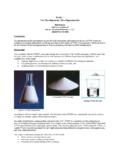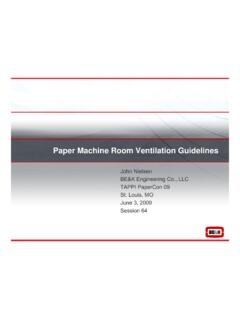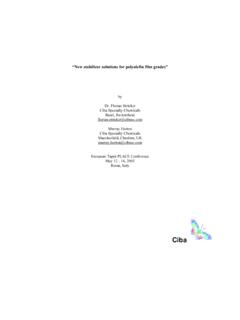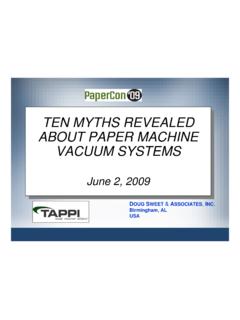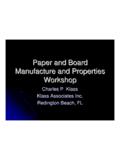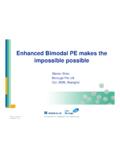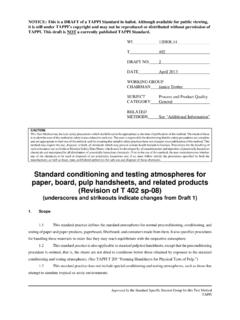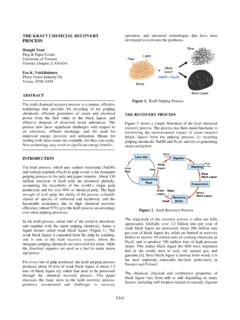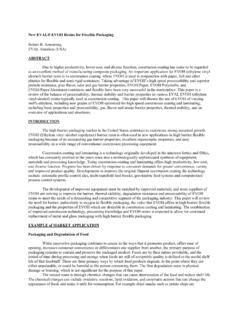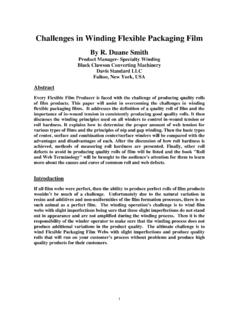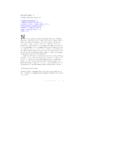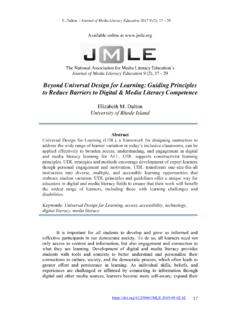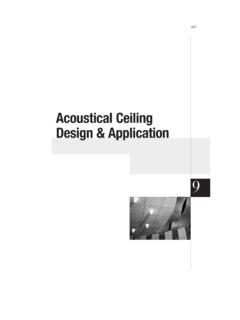Transcription of SCREW DESIGN BASICS - TAPPI
1 SCREW DESIGN BASICSThe Processor Point Of ViewAndrew W. ChristieOptex Process Solutions, Define the goal Review basic extruder components Discuss process elements Look at basic SCREW DESIGN features Put the components together Review process function optimization Discuss operator control and assessment Wrap Up What is the goal?Provide the melted polymer to the forming process at the desired rate, uniformity, and quality to produce the finished product within Goal: Thin films & coatingsScrew NomenclatureTRANSMETERMIXMETERFEEDS teps In The Process (Feeding to the extruder) Solids Conveying Melting Pumping MixingTake NoteThe single SCREW extruder is basically a volumetric pump. It is not a positive displacement device. Variations in feeding result in variations in output. Solid conveying, melting, pumping and mixing occur simultaneously and are inter-dependent. Resin FeedingFeeding of the extruder is independent of SCREW DESIGN .
2 For successful operation of any single SCREW extruder a consistent feed stream must be supplied. The feed stream must be of uniform composition and uniform Feeding Driven by Gravity Opposed by Frictional forces Escaping air from compaction Centrifugal force due to SCREW rotation Optimum Conditions Low COF Pellets to Hopper Low COF Pellet to Pellet Large Volume to Surface Ratio of Pellets Large OpeningRemember the process steps (Feeding to the extruder) Solids Conveying Melting Pumping MixingProcess steps relate to DESIGN featuresSolids Conveying Driven by Sliding Force Pellet to Barrel Opposed by Sliding Force Pellet to ScrewSolids Conveying Optimum Conditions High COF Pellets to Barrel Low COF Pellets to SCREW Channel High COF Pellet to Pellet Soft for Easy Compression All temperature dependent Low Surface to Volume Ratio of Pellets Material dependent High Channel Width to Depth Ratio SCREW DESIGN dependent Static COF Data - GregoryStatic COF Data - GregoryLDPE Solids Conveying SCREW RPM = 80 Root Temperature = 50 C SCREW Diameter = mm Channel Depth = mm SCREW RPM = 80 Root Temperature = 100 C SCREW Diameter = mm Channel Depth = mm An Experimental Investigation of Solids Conveying in Smooth and Grooved BarrelSingle SCREW Plasticating Extruders , Conf.
3 Proceedings, ANTEC 98, pp 136-141 Rate is Solids Conveying Output rate has a direct correlation to solids conveying The operator can impact solids conveying through temperature control in the solids conveying zone SCREW Root Temperature Feed Cylinder Temperature Barrel Zone Temperature (s) [over solids] Pressure variation indicates rate variation Correct with stable solids conveyingPut the SCREW in the system!Melting Driven by Viscous Heat due to Shearing Heat Conduction from Adjacent Poly Heat Conduction from Barrel & SCREW Opposed by Heat RemovalMelting Optimum Conditions High Viscosity & Shear Rate Large Solid Interface with Barrel Small Channel WidthMelt Separation BarrierMelt Separation BarrierPumping Driven by Drag Flow Opposed by Pressure FlowDrag FlowFlow Path Along A ChannelFlow Velocity ComponentsPumping Optimum Conditions Low Head Pressure High Entrance Pressure High SCREW Speed High Melt ViscosityMoving wallVelocity inside the SCREW channelVelocity inside the SCREW channelVelocity inside the SCREW channelMixing & Mixtures Two types of mixtures Solid in liquid Liquid in liquid Two types of mixing Dispersive DistributiveDispersive MixingDeformation of the comingled components resulting in a reduced component size and increased interfacial area.
4 The deformation being accomplished through shear, elongation, or compression or in MixingA repetitive random or ordered bulk rearrangement of the comingledcomponents. Does not require continuous deformation of the Polymer Melts with Liquids One polymer with large bulk temperature gradients Alloys of two or more polymers A polymer with minor components Plasticizers Stabilizers Liquid Colorant LubricantMixtures Polymer Melts with Solids Polymer melt with unmelted polymer Polymer melt with other solids Pigments Flame Retardants Nucleating Agents ContaminantsMixer Performance Dispersion Distribution Efficiency Pressure Drop Streamlining Relative Surface AreaMaddock s (UCC) Mixer Dispersion high shear over barrier Distribution splits & recombines flow Depends on pressure for flow Dead ended channelsGregory (Egan) Mixer Dispersive high shear over barrier Distribution splits & recombines flow Helical channels pump at all speeds Dead ended channelsPineapple Mixer Dispersive No high shear path Distributive Multiple flow rearrangements Minimum pumping due to flight cuts Very large wetted surface areaRemember the goalProvide the melted polymer to the forming process at the desired rate, uniformity, and quality to produce the finished product within Your System Resin Feed System Hopper Volumetric Feeder Gravimetric Feeder Root Cooling Depth Temperature Control Feed Cylinder Cooling Length Temperature Control Barrel Heating Zone Lengths Number of Zones Type of Heating / Cooling SCREW DESIGN Type of SCREW DESIGN Original DESIGN Specification (Specific Mat l Rate Verification)
5 Relationship of SCREW DESIGN Features to System ComponentsExtruder PerformanceThere is only one measure of extruder performance and that is melt quality. This is reflected in quantitative on-line measures as well as product performance Quality Temperature Uniformity Pressure Uniformity Mixing and Dispersion Residence Time DistributionExtruder thermocouples Control Thermocouples Mounted in extruder or component wall to provide feedback for heater control Melt Thermocouples Flush with polymer flow surface (T&P) Immersed into the polymer flow Shielded junction Exposed junction Adjustable depth immersion IR ProbeVariable Depth ProbeControlMelt3 mm6 mm9 mmPossible Temperature PatternWallCenterMeltSystem ComponentsExtrusionProcessConverterIR ScannerRS485 PCRS232 BoxRS232 Trigger Alarm+Laser+ Adjustable Mounting Base+ DataTemperature SoftwareIR Scan of Melt CurtainMelt Quality Odor Gel Count Optics MVTR Physical Properties Heat Sealability Weatherability Wear Resistance ColorSummary The Goal is to produce an output and melt quality appropriate for your product In order to get the most from your system Know the system component arrangement Know the SCREW DESIGN system component relationship Get quality real time feed back Control temperatures / speeds Gravimetric rate Melt pressure Melt temperature Time dependent Position dependentThank YouAndy ChristieOptex Process Solutions.
